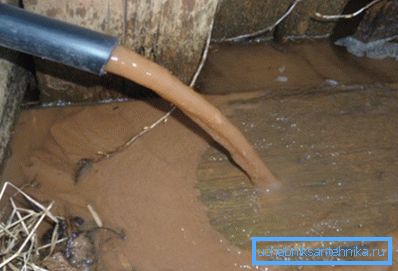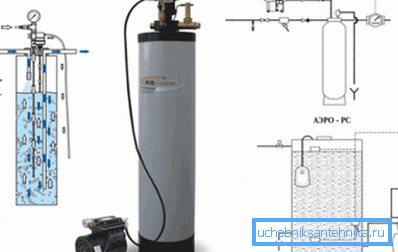Hydrogen sulfide in water from a well: causes of occurrence
If the water in the well smells of hydrogen sulfide, do not tolerate and ignore this phenomenon. The appearance of unpleasant odors most often causes pollution of the aquifer, which is desirable to eliminate as soon as possible. Well, if elimination is impossible - then at least take measures to clean the water and bring its basic parameters to standard values.
In our article we will describe what the reason for the appearance of an unpleasant smell can be, and what needs to be done in such a situation.

Nature of the phenomenon
Main reasons
Quite often, after the completion of drilling operations, the well works perfectly: the water goes clean, free of impurities and odors. This usually indicates that the instruction was followed, and all work was done at a high level..
However, over time, the water quality deteriorates. Most often this manifests itself in an unpleasant smell (it smells like “swamp” or rotten eggs), which eventually gets stronger and becomes almost unbearable from the almost imperceptible. In most cases, this indicates a high content of hydrogen sulfide.

As a rule, it is released as a result of the vital activity of anaerobic (i.e., living in an oxygen-free environment) bacteria. In the process of life they use the energy of chemical bonds, and hydrogen sulfide is one of the by-products of this process.
Note! In addition to hydrogen sulfide, bacteria also secrete mercaptans, dimethyl sulfide, 2-methylisobornol, etc. None of these substances can boast a pleasant smell.
There are several answers to the question of why well water smells of hydrogen sulfide:
- First, most often the outbreak of sulfur bacteria occurs after heavy rains and floods. Water, filtered through layers of soil to the aquifer, captures sulfides and sulfates, which are the nutrient substrate for bacterial cultures.
- Secondly, this occurs when the casing is not tight. In this case, the sulfur compounds will fall into the water much faster - even a little rain will suffice.
- Thirdly, there is a risk of sulphurous ores getting into the well during its drilling. However, in this case, the smell you feel pretty quickly.

Note! If, in addition to sulfur, petroleum products or chlorine are also mixed with the smell, then we can confidently talk about man-made pollution. This means that some enterprise has relatively close to the uncontrolled burial of waste, and some of them fell into the aquifer.
Possible consequences
As we noted at the very beginning, one should not endure in any way:
- Water smelling of hydrogen sulfide is not suitable for drinking, cooking and technical needs. Not only does it have a very unpleasant smell - its use can lead to poisoning.
- Watering the site with such water is also not worth it. On the one hand, there is a risk of inhaling hydrogen sulfide vapors (intoxication is almost guaranteed), on the other hand, the uncontrolled release of sulfur compounds into the soil can seriously damage the plants.
- For the well itself, the situation also does not pass without consequences: the surface of most metal parts is subjected to severe corrosion.

In any case, this situation requires immediate correction. What can be done if you feel a distinct smell of hydrogen sulfide in the water from the well, we will tell in the next section.
Methods of struggle
Preliminary processing
It is possible to cope with the problem with your own hands, but still it’s better to involve in the first stages those who performed the drilling and development of the well to solve the problem. If the guarantee has not expired, it is quite possible that consultations and some work will be carried out free of charge.
First you need to put in order the well itself:
- Since microorganisms that secrete sulfur compounds show special activity with an excess of magnesium and iron in water, it is worthwhile to clean the walls and bottom of the well from sediments. In most cases, this solves the problem for at least a year or two.
- It also does not hurt to perform pumping, removing bottom deposits of clay particles and sand. Since there are colonies of sulfur bacteria, when pumping, we eliminate their bulk.

- We should also take care of the tightness of the casing. It may even be necessary to complete the reconstruction. Expensive, of course, but you have to go to these expenses - the price of a new well will in any case be much higher.
When all these activities are completed, you can proceed directly to removing odor from the water.
Physical method
The first cleaning method is physical. It consists in displacing hydrogen sulphide from water using air.
To implement this method, we will need a special device - an aerator:

- In the pit, caisson or other room install an aerator with an attached pump.
- The water from the well enters a hermetically sealed container with a tap and a valve to release the gas.
- Under the action of the pump, air is forced into the device, which displaces hydrogen sulfide. In this case, an excess of oxygen in water leads to the death of sulfur bacteria.
- An additional advantage in this case is the enrichment of water with dissolved oxygen, which in itself benefits the human body.
Tip! Some techniques include pre-acidification of water, which also leads to more efficient purification.
This method is not without flaws. The main disadvantage is the cumbersome equipment, the need to purchase a separate aeration pump, as well as the power consumption of the entire system.

Chemical
An alternative to aerating the well water may be its chemical cleaning.
At the same time to remove hydrogen sulfide impurities can be used:
- Ozone.
- Hydrogen peroxide.
- Sodium hypochlorate.
- Carbon filters.
Most often, the process of preparation for operation is as follows:
- Water enters a separate container.
- An oxidizer is fed into the tank.
- Hydrogen sulfide is oxidized to insoluble compounds that precipitate.
- The treated liquid passes through the filter, where it can also be softened and enriched with useful minerals.

A variety of chemical method is sorption-catalytic purification. In this case, a catalyst is fed into the water, which accelerates the process of oxidation of sulfur compounds. The sorbent is activated carbon, which accumulates insoluble sulphates and thiosulphates. Over time, the adsorbing units need to be replaced, since the pores in the coal are filled relatively quickly.
Conclusion
Water from a hydrogen sulfide odor well can be cleaned in several ways. However, in order to save money and ensure a positive result, before starting work it is necessary to establish the nature of pollution as precisely as possible.
Only in this case will we be able to effectively plan all the activities and choose an effective cleaning method. The procedure is shown in more detail in the video in this article, so carefully study it to find answers to your questions.